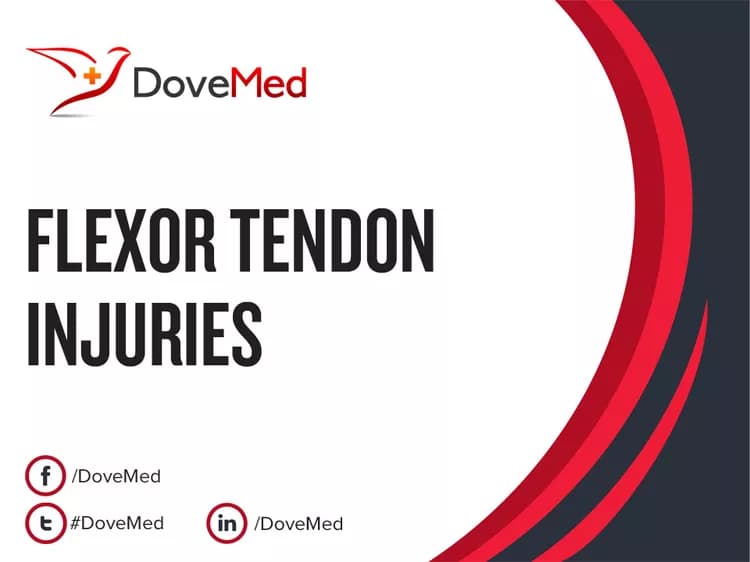What are the other Names for this Condition? (Also known as/Synonyms)
- Jersey Finger
What is Flexor Tendon Injuries? (Definition/Background Information)
- The flexor tendons are strong bands of connective tissue that connect the flexor muscles (in the forearm) to the finger bones, allowing proper function/flexing of the fingers
- Flexor Tendon Injuries are common injuries that occur, when flexor tendons of the fingers are stretched or torn
- This injury is usually caused by athletic sports, direct fall, or other significant traumatic events
Who gets Flexor Tendon Injuries? (Age and Sex Distribution)
- Flexor Tendon Injuries are non-specific injuries, and as such, may occur in individuals of any age, race, ethnic group, and gender
- Athletes, who participate in any high-impact sport, have a high rate of incidence of the condition
What are the Risk Factors for Flexor Tendon Injuries? (Predisposing Factors)
Common risk factors associated with a Flexor Tendon Injury include:
- Participation in high-risk contact sports, such as football
- Chronic inflammatory disorder (rheumatoid arthritis)
It is important to note that having a risk factor does not mean that one will get the condition. A risk factor increases ones chances of getting a condition compared to an individual without the risk factors. Some risk factors are more important than others.
Also, not having a risk factor does not mean that an individual will not get the condition. It is always important to discuss the effect of risk factors with your healthcare provider.
What are the Causes of Flexor Tendon Injuries? (Etiology)
A few cause factors of Flexor Tendon Injury include:
- Falling from a significant height; especially landing on one’s hands (or the injury occurring since the individual is overweight)
- Taking part in any rough or high-impact sport
- Direct trauma to the finger, due to an automobile accident
- Chronic inflammatory disorder (rheumatoid arthritis), which may cause deterioration of the flexor tendons
What are the Signs and Symptoms of Flexor Tendon Injuries?
Signs and symptoms of Flexor Tendon Injury include:
- Noticeable pain, swelling of the finger
- Feeling of tenderness; decreased sensation in the finger
- Difficulty bending the finger or joint
How is Flexor Tendon Injuries Diagnosed?
Diagnostic methods that a physician may use to help diagnose a Flexor Tendon Injury include:
- Physical examination: A thorough physical examination is important to assess the range of motion, strength, and stability of the fingers. Individuals are also expected to provide an explanation of the circumstances that caused the injury. In addition to this, a complete medical history can aid in arriving at a definitive diagnosis
- X-rays: X-rays use radiation in order to produce images of the hands/finger. They help the physician rule out other possible causes for discomfort, such as a fracture
Many clinical conditions may have similar signs and symptoms. Your healthcare provider may perform additional tests to rule out other clinical conditions to arrive at a definitive diagnosis.
What are the possible Complications of Flexor Tendon Injuries?
Complications associated with a Flexor Tendon Injury include:
- Rupture (complete tear) of the flexor tendon
- Formation of adhesions
- Infection of the finger/hand
- Permanent damage to the nerves and blood vessels
How is Flexor Tendon Injuries Treated?
An injury to the flexor tendon usually requires immediate medical attention. Nonsurgical treatments of a Flexor Tendon Injury include:
- Any activity that aggravates the finger/hand condition should be avoided. The physician may advise the individual to refrain from participating in any physical activities, till the pain or symptoms get better
- Applying ice to the finger/hand can help reduce pain and swelling
- Complete immobilization of the finger with a cast, may be required to restrict movement
- Non-steroidal anti-inflammatory oral medications, such as indomethacin and naproxen, may be used to treat Flexor Tendon Injuries. These medications can help decrease the pain and swelling
- Individuals are likely to need physical therapy exercises after the cast is removed. The goals of these exercises are to strengthen the bicep (forearm) muscles, improve flexibility, and decrease stiffness. It may take several months for an individual to complete the physical therapy program and regain full strength and functionality
Surgical treatment methods include:
- Open reconstructive surgery: It is a surgical procedure to repair the injured ligaments, using surgical orthopedic devices, such as stitches or suture. In this procedure the physician usually replaces the damaged ligament of the finger, with another redundant healthy ligament from another part of the body
How can Flexor Tendon Injuries be Prevented?
To prevent Flexor Tendon Injuries, individuals should be careful and consciously aware, while performing any physical activities, such as sports, or even some normal daily activities that could lead to situations involving accidents. Children must be provided a safe environment to work, study, or play. Any possible dangers should also be anticipated and appropriate safety measures adopted.
A few ways to further help prevent unwanted injuries or a Flexor Tendon Injury include:
- Individuals, who participate in any high-risk sports, should wear appropriate safety equipment
- Wearing appropriate footwear (such as the proper shoe size) may help prevent accidents
What is the Prognosis of Flexor Tendon Injuries? (Outcomes/Resolutions)
- A majority of Flexor Tendon Injuries heal without any serious complications
- When properly treated and rehabilitated, usually under the guidance of a physiotherapist/specialist, a high percentage of individuals regain their full strength and complete range of motion in the injured finger/hand
Additional and Relevant Useful Information for Flexor Tendon Injuries:
Trigger Finger is a common deformity that occurs when the extensor tendon in one of the fingers or thumbs, become locked in a certain fixed position.
Related Articles
Test Your Knowledge
Asked by users
Related Centers
Related Specialties
Related Physicians
Related Procedures
Related Resources
Join DoveHubs
and connect with fellow professionals


0 Comments
Please log in to post a comment.